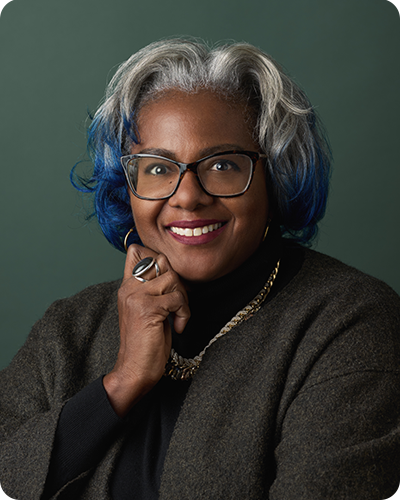Subscribe to Catalyst
Subscribe to get our magazine delivered right to your inbox
Related Articles
Australia’s Black Dog Institute blends research and community spirit. A conversation on outreach, balance, and the art of “business in the front, party in the back.”
If you’re fortunate enough to visit Sydney in September, you might notice something odd: a whole lot of mullets.
That’s because each year, the Black Dog Institute (BDI) runs their Mullets for Mental Health campaign, where Australians are encouraged to grow their hair in the much-maligned style leading up to the fundraising period. Top earners — those whose business-in-the-front, party-in-the-back haircut brings in the most money — can also take home rewards — including the coveted mullet-wig hat.
The mullet offers an easy opening to raise awareness and funds for mental health research, much like Canada’s Movember moustache campaign does for men’s mental and physical health.
For Helen Christensen, who was BDI’s director for nearly a decade, campaigns like this are doubly beneficial. “We’ve built up a reputation within the community,” she said. “People are more likely to get involved because they know who we are, and our organization is more sustainable as a result.”
The Black Dog Institute — named for the way Winston Churchill once described his depression as “my black dog” — is Australia’s only medical research institute to investigate mental health across the lifespan. Before Christensen joined BDI in 2012, it was already doing innovative work, mainly studies on treatment-resistant depression while educating clinicians and other researchers about those findings, although it was relatively unknown outside the psychiatric community.
Using her background in population-based research, Christensen helped bring this work out of the hospitals and into the community. Those efforts included a strategic shift to internet-based, technology-driven, broader-scale community and longitudinal research. Rather than focusing on clinicians, BDI began offering education in schools and management training for workplaces.
While research is foundational to the “business” part of BDI’s work, their community events are now what drive it forward. That’s the “party in the back” part.
Community-based campaigns put the fun into fundraising while reminding Australians that no one is immune to mental illness. They are built around activities that encourage togetherness, like races, obstacle courses, and other ideas from community members.
Leading with lived experience
Yet BDI is equally committed to integrating the experiences of people with lived and living experience (PWLLE). Describing the growth of this area of expertise, Christensen explained that it started as an open call advisory group (much like the Hallway Group and Youth Council at the Mental Health Commission of Canada) but then evolved into a dedicated branch of the institute.

Black Dog Institute
“We embraced lived experience early on but also recognized that it needed to be structured in terms of how that expertise was incorporated into the rest of the organizational activities,” she said. “It needed its own framework and processes, its own staff, its own network, and its own volunteers. Some of the framework is still emerging, but it’s the people with lived experience themselves who lead that process.”
Likewise, PWLLE among Australia’s Indigenous populations is integrated into the institute. Through their lived experience Indigenous centre, BDI helps with things like research and project management. But as Christensen emphasized, “doing this kind of work isn’t as simple as saying, ‘We want to do Indigenous mental health, let’s set it up.’”
“You’re the host for that organization or movement, you’re not the driver of it, and you’re not doing it for them,” she said. “If you’re lucky enough to be a respected organization that they trust and can fit their work with, then you can help — but first you have to be invited.” As this focused approach has evolved, Indigenous partners have become a cornerstone of the institute.
Prevention and progress
While Christensen stepped down as BDI’s director in 2021, she remains deeply committed to improving mental health — and saving lives — across Australia. She continues to challenge the status quo with a special emphasis on suicide prevention in her current positions as professor of mental health at the University of New South Wales and non-executive director on the BDI board.
Suicide prevention is nothing new for BDI, which offers a rich collection of research and resources in the field. But according to Christensen, a critical piece of the puzzle is still missing: data.
“It’s like trying to work blindfolded. There’s a lot of misinformation and catastrophizing in the absence of real data,” she said, adding that accurate statistics around self-harm and suicide attempts simply don’t exist.
In one example, Christensen relayed the story of a student who took an excess of pills in an attempted overdose. “She awoke in the morning and was physically OK, so she just got dressed and went to university like nothing had happened. That attempt wasn’t tracked anywhere. How often is this happening? We don’t know.”
To help close these data gaps, she believes in the value learning from other sectors. “Car dealerships have all kinds of data to improve business. Banking apps use metrics to see exactly which investments are paying off and which are not. Why can’t we have the same thing to improve the ‘business’ of suicide prevention?”
Leveraging digital tools
When COVID-19 forced people indoors, health care of all kinds shifted to virtual services, including mental health. Today, BDI continues to champion evidence-based digital mental health tools and resources and to investigate the effectiveness of apps. At the same time, Australians can request free counselling, peer support, and other telehealth services through the institute.
While the influx of digital health tools has made treatment options more accessible for many, as Christensen pointed out, it’s not a panacea. “The stand-alone services we can now offer virtually haven’t been integrated into our broader health system,” she explained. “Without an integrated health record that can report back to the care provider, there’s no way to confirm if people actually got better following treatment. That’s a major problem.”
For Christensen, this digital shift brings an unprecedented opportunity to overhaul what is often a disjointed system. “What I would like to see is integration — a model of care that includes digital health, and a technology platform that can deliver it. Only then will we see a true collaborative, patient-centred model of care.”
Despite current limitations in data and access to care, Christensen remains hopeful that digital tools and data collection have great potential, particularly for suicide prevention. “If we think about cancer and infectious disease, there’s been amazing changes over 40 years in how people are treated. Suicide prevention, on the other hand, is still a new field.”
“With better data to improve outcomes, more capacity to provide integrated care, and a focus on the social determinants of health, I believe we can really turn up the dial on mental health.”
Resources
Karla is the VP of programs and priorities at the MHCC.
Subscribe to Catalyst
Subscribe to get our magazine delivered right to your inbox
Related Articles
After the murder of George Floyd, and further acts of anti-Black racism and discrimination, many African, Caribbean, and Black people came forward — online, in mass media, and in the streets — to advocate for justice and change. Yet, for some, carrying the torch gets heavy as movements evolve and injustices continue. Finding the activism that’s right for where you’re at.
One of Melicia Sutherland’s earliest memories was from the day a teacher called her the n-word. She was in Grade 2.
“I was outside during recess, and I remember the teacher saying, ‘Everybody come inside now,’” Sutherland said. “The students were entering through the large doors, and I was next in line. The teacher slammed the door in front of my face and called me the n-word. I didn’t know what that word meant. I just felt like I did something wrong. Otherwise, why would this grown-up close the door on me and let everybody else inside?”
Sutherland recalled feeling a gamut of emotions while returning home from school: anger, embarrassment, shame. But later, curiosity arose after she asked her mom what she thought the teacher meant. “My mom was like, ‘I don’t know,’ and we kind of left it alone.”
Becoming the other
If only it was that easy. In the face of constant reminders of her Blackness, there was actually no way for her to leave it alone. After her experience with the teacher, she realized that she’d sensed something like it as far back as kindergarten, when she felt separated from the other children physically and psychologically.
That was in 1989, when at age five she moved with her family from Montego Bay, Jamaica, to the Toronto suburb of North York. Immediately, and for the first time, she had a sense of being an “other.”
“Teachers would take me out of the classroom and play with my hair while other kids were learning the alphabet,” she said. “I’ve always been like this little Black doll that non-Black people wanted to play with.”
Living with discrimination and the experience being treated as other eventually led Sutherland to realize the importance of seeking social change. “As I got older, and as I was trying to create and maintain a certain character and value system for myself, I reached the point where I had to become an activist,” she said. In the summer of 2020, Sutherland joined the Remember The 400 march in Toronto, motivated by the quest for justice for the killing of George Floyd.
She has still not seen the nearly 10-minute footage showing how he lost his life at the hands (or knee) of a police officer. For her own mental health, Sutherland intentionally stepped away from the 24-7 news cycle about the incident. “I was being bombarded with images and people were sending me videos. I don’t want to see anybody die; it hurts my soul. I came off social media because it’s not good for my mental health,” she said.
She also believes this act of self-care does not diminish her activism.
“It’s self-preservation. I don’t like those things because it becomes like Black death porn. People want to see it, and this kind of voyeurism happens, but I’m not here for that. So yeah, I’ve never seen the video, though I wanted to be a part of something I thought was going to bring significant change.”
And, while traumatizing, the response to anti-Black violence — seen, heard, and felt in the media and within African, Caribbean, and Black (ACB) communities — has also helped make a difference. According to a peer-reviewed National Academy of Sciences study, Black Lives Matter (BLM) protests have broadened the social conversation on anti-racist topics.
As the research showed, street demonstrations were an important first step for creating social change and shaping how people think about racism. Protests have also helped redefine the ways people learn and consume information about Black communities as they seek to reconcile issues about race and police violence. In addition, the study noted how individuals are showing up and re-making their own activism against racial inequalities.
At the same time, activism isn’t a one-size-fits-all proposition. The “active” part of activism doesn’t need to be direct or even active. Nor does it always mean marching, holding picket signs, or chanting the need for social change.
Sutherland’s activism “has always been through the arts, through spoken words, through language, through visuals — even doing hair. It’s not just marching,” she said. “What changes things is engaging at the ground level. It’s what you do in your immediate community, in your family, and with your friends and neighbours.”
Disengage to re-engage
Nicole Franklin, a registered social worker, psychotherapist, and clinical director and founder of Live Free Counselling and Consulting Services in Toronto, shares that belief. Since 2017, her Black-led, Black-owned organization has helped fill the gap of too few Black therapists in racialized communities. It has also provided education and training in Black mental health. For Franklin, “Black resistance” involves Black people’s everyday acts of resistance against white supremacy and colonialism within the political, economic, and social systems that push ACB communities to society’s margins. Such resistance is diverse and can take many forms, whether in classrooms, boardrooms, or on the streets. “Black people access self-care through joy, art, dance, passing down recipes — even cooking, which can also be an act of self-care and community care,” she explained. “This is the stuff we don’t talk about enough.”
While there is a diversity of forms, Franklin is quick to mention that continuous resistance can be counterproductive. “We shouldn’t always have to be resisting as Black folks. We also have the right to just be. Disengaging or tapping out can allow you to reconnect with self and the community, because part of activism is knowing when to pause and take a rest. Ask yourself what brings you joy? What ignites your creativity? It is our birthright to re-imagine oppressive systems and to have safe spaces to thrive rather than just focusing on surviving,” she said.
“Being Black can sometimes carry heavy expectations to be a spokesperson for BLM and similar movements on behalf of the entire Black community. Black people are not a monolith, and it’s not our job to teach co-workers, peers, or others when we don’t feel safe, ready, or able to engage in these conversations. (Plus, we are tired!) Black folks require safe spaces to respond on our own and must not forget to celebrate Black excellence and Black futures.”
For Sutherland, that means authentically and unapologetically embracing the freedom to explore her Blackness, including her “dark skin, kinky hair, thick lips, almond eyes, and full cheeks.” That said, her activism in her east-end Toronto community — which includes running leadership programs and facilitating violence intervention programs — supports all shades and colours, not only Black ones.
“People are always like, ‘Oh, Mel, you’re so pro-Black.’ I don’t want to carry the burden of representing my race because, and I say this with a gentle heart, skin-folk don’t mean kinfolk,” she said. “Many of us are Black and don’t at all share the same values, the same ideals, or the same goals. I don’t want to feel like I’m representing my entire race. I’m not a Black supremacist. I can’t stand white supremacy — why would I support Black supremacy? It’s weird. Thinking you’re better than anybody else is a weird thought process to me.”

Melicia Sutherland
One of Franklin’s goals in her therapy and community wellness practice is to support Black clients through their experiences of racism and racial trauma by developing action plans while validating their feelings and letting them know they are not alone. But she also stops short when it comes to Black people carrying the burden of anti-Black racism on behalf of the entire race.
“Racism, which is often internalized, impacts our mental health; it should be viewed as systemic issue, not treated as a personal deficit. I don’t think it’s always our responsibility to be out in the streets or online educating people all the time,” she said. “Sometimes all one can do is just be. Rest is also an act of resistance.”
Like the diversity among Black people across Canada, there are many ways for a Black person to decide how to participate in activism — and in their own self-care and community care. The overwhelming, traumatizing, and tragic events in the media around anti-Black racism involves radical transformation and cannot be sustainably or justly carried on the shoulders of individual Black people.
Activism for where you’re at
Angelique Benois, an advanced practice mental health nurse, psychotherapist, mental wellness consultant, and the director of Nurturing Our Wellbeing, recommends that the ACB community strike a balance between staying informed and internally absorbing the news on anti-Black violence.
“I strongly advise that, when people get informed about world events and receive media updates, that they do so with intention,” she said. “Because we are exposed daily to events that can cause emotional turmoil, our self-care practices need to become part of our lifestyle.”
In describing the way our mind and body can hold onto these images — and eventually let them go — Benois said, “It goes back to how our brain works. One of the many things our limbic system is responsible for is storing our memories and helping to assign meaning to them. By storing every racial aggression we’ve witnessed, every harmful event we’ve experienced, it has the potential to influence any of our future decisions and encounters, including our regular daily flow. As we become clearer on how certain internal mechanisms and systems in our body influence how we feel, think, and act, it starts to make sense how certain self-care practices could create a shift in outcomes.”
Franklin echoed this idea in terms of how each of us can re-evaluate what self-care means individually, apart from any commentary or criticism of what activism “should look like” from an outsider’s perspective.
“Redefining what self-care means is built within community care and is about healing ourselves and our Black communities. It doesn’t always have to be loud actions. Everyday underground acts of resistance are also important,” she said. “And for Black people, the self-care conversation goes far beyond discussions about ‘spa days’— it’s about engaging in social justice and taking time to rest. We need to bring new realizations to the exploration of self-care and community care, while allowing space to reimagine post-colonial worlds. As a Black woman, I feel one of the strongest things we can do is learn how to take care of ourselves and our mental health, while supporting one another and working together toward change.”
For the next generation of ACB activists, this is the self-care advice Sutherland gives and practises herself — including showing up for fellow members of the ACB community. “I feel like that’s the best way I’ve been able to maintain a healthy mentality and make sure to be around allies because I don’t want to have these ‘everybody hates us glasses’ on.”
I asked Sutherland what she would say to the teacher who called her the n-word if she could travel back in time.
“I would say, ‘It’s not right, but it’s OK,’ like the famous Whitney [Houston] song. At that time, I didn’t even know what that word meant. But I understood the intent: it was to hurt me. Words for me are very powerful and I take them to heart.”
Black Like Whom? Why we use ‘ACB’ over ‘Black’ from the Mental Health Commission of Canada. Inset photo: Melicia Sutherland. Credit: Juanita Muwanga
Subscribe to Catalyst
Subscribe to get our magazine delivered right to your inbox
Share This Catalyst
Related Articles
Figure-eighting through pain into possibility
This story is the last in the Mental Health for the Holidays series. While end-of-year celebrations can be a time of joy — they can also trigger feelings of stress and loss. Read the collection to learn how others were able to meet those challenges.
In 1984, I started skating again.
I’d skated as a kid, but this was more. This was devotion — eventually, obsession — that came after years away from the ice, having rejected sports because of what it represented to a kid into punk rock, politics, rebellion, and art. Sports was the status quo and the domain of jocks. It was a mainstream opiate and a place where men and women — mostly men — went to behave badly. But skating. Skating was different. Skating was an easy return, shorn of contact or competition.
I began under the lights of Valleyfield in Etobicoke — even the name sounded comforting and bucolic in sub-zero temperatures — and moved to rinks around the city: Weston, Rosedale, Ramsden, Dufferin Grove, Regent Park. I skated the city, even writing a story on it for the Toronto Star about how one could travel east to west across its frozen surfaces, like Burt Lancaster’s The Swimmer but in winter. I bought a pair of used skates, then another, and then a new set of Bauer 300s, bragging about my latest, best purchase to anyone who’d listen.
At first, I didn’t think skating was helping my head as much as it was helping my body, making it come alive in new ways and new settings: chugging against the cold and wind and working up a sweat while moving, a new concept for someone who’d suffered through the relative inertia of sit-ups and crunches. With skating, exercise was about constant motion eating up every inch of ice. And even though I wasn’t the kind of rink rat who imperiled kids with their looping O’s or berated older, slower skaters for getting in the way of their slaloms, the rest of the world dripped away. I felt free and good, even at my casual pace. My blood felt hot against the cruel wind, my legs deliciously sore after skating laps till nearly midnight, when someone blew a whistle and the gate shut.
Skating was partly about the pure joy of movement and partly an act of nostalgia meant to recapture those times before my world was complicated by having to choose between sports and music. I’m 59 now, but I still feel reborn into the young world while icebound, trying to get at growing up again, then again, and again. The truth is, it’s a melancholy act — if it had all gone so well the first time, I never would have stopped — and because I learned soon enough that being active also helps your head, skating fed my imagination and sense of memory. Yet where it led wasn’t always my frozen pond romance or youthful bliss. It also returned me to my most difficult years.

When it came time for me to write another book in 2013, my love of the ice pointed me back to something that happened in Grade 7 at Dixon Grove Junior Middle School in Etobicoke. That year, I was bullied by a taller, bigger kid named Roscoe (not his real name), who savaged me every day after class. I was too humiliated, and terrified, to tell anyone about it, even though he often preyed on me on the school grounds, in full view of students, teachers, and passers-by. No one ever stopped and wondered why that kid was sitting on the other kid punching him in the back of the head. Maybe some thought it was just what kids do — not untrue, sadly — but why no teacher ever did so became more troubling the more I dove into the memory. I used all of it as a framework for the book Keon and Me, where I tell the story of that year in alternating sections — one, in the third person, from the perspective of me at 11, and another, in the first person, from the perspective of me in my 50s, looking back. I was grateful that skating had delivered this creative idea to me at the expense of having to relive the stress, pain, and anger that came with reconstructing those times. I’d tried to make art through a discovery of this nostalgia. But nostalgia often uncovers the raw truths of the past while celebrating the best parts of being young and simple and new to the world.
Even though skating — and now, hockey (two or three times a week for the past thirty years) — is a beautiful way to keep moving, it’s also a place where I go to think. This may push against one’s natural impulse to find a pretty open space and let your thoughts reel, but I find that when I’m moving and playing doors get unlocked and windows are cracked open. I think with a kind of freshness brought in by the cold arena or outdoor rink, and my consciousness is freed by having to dwell on nothing other than the joy of play. Ideas for songs and stories — melodies, narratives — find me when I’m on and off the ice, sitting on the bench waiting for a shift or lining up for a face-off after the play has been whistled dead. Softball, tennis, golf, basketball — I’ve done all these things. But none of them has teased out or produced new ideas the way hockey has. I think everyone has something that gets them to this place — playing the cello, knitting, cycling, alphabetizing your albums — and this is what works for me. I’m grateful I found it, and grateful it found me.
I won’t skate forever; no one does. But while most will lament each year’s turning calendar page — in COVID times, the winter’s dark and cold is ominous for those who must avoid indoor groups to avoid the risk of infection — I’ll look forward to the cold because, for me, its arrival has always meant the promise of ice and the expectation of play. The ground will freeze and smoke will rise out of rink houses.
I’ll be skating again.
How to Give Back (or Reach Out) This Holiday Season (Mental Health Commission of Canada)
Five Ways to Protect Your Mental Health This Holiday








